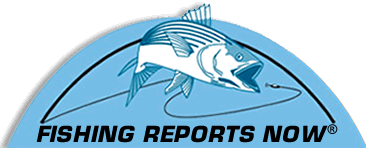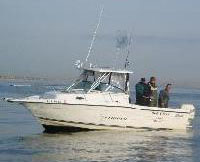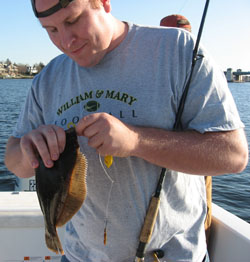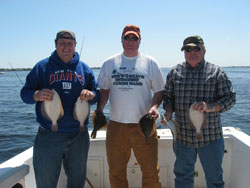Prime Real Estate |
||
|
Location, location, location. In fishing, the right location is one The Manasquan River is a top location for winter flounder fishing. No use arguing that it’s the location. That’s like apples and oranges. Even in New Jersey, several other waters give up equally impressive catches. But there’s no better location in the state. However, there are differences among them. Understanding the differences Conditions like weather, tides The sun might be too bright one day, and the fish will turn off, he said. Or the next day might be too cloudy. It’s as crazy as that. As this article was being written, flounder had suddenly stopped biting in the river for days. All kinds of reasons were speculated. Persistent winds. A few rainstorms. Slightly cooler water. The new moon. Maybe all were the reason. Maybe none was. Nobody knew. But anglers knew the fish would bite again. If they started feeding again when winds were gusting, a cold front was pushing through and rains were flooding the river, who wouldn’t smile? |
|
Sometimes there’s no use trying to figure it out. Like anywhere, the flounder spend the winter far up the back waters, in the warmer water, away from the cold ocean. In early spring they’ll spawn in the bay and creeks and then start migrating to the ocean, eventually to the Continental Shelf for the summer, before making the return trip in fall. When flounder season opens, currently in late March, the fish are mostly swimming the bay. When the mean low water temperature hovers in the high 40s to low 50s, the fish will start moving out, maybe by early April.
The flatties will gradually move from the river to the inlet through the month, until they disperse in the ocean. They can be caught at the inlet until the water reaches about 55 degrees, but that depends on other factors, like whether bluefish invade earlier and scare them off. In this area, once the flounder hit the ocean, they disperse too much to target with hook and line, Allen said. The bay and river force them to congregate, but the ocean in this area is wide open. He might target them in the ocean farther north, at the Cedars off Sandy Hook, a good spot in late April. But that depends on whether the runs of striped bass and bluefish become more interesting to charters by then. Some aspects of the river’s fishing are no different than anyplace else. The best tides for the Manasquan River area’s flounder fishing are similar to other waters. In the early season, outgoing tides are usually best, because they push through warmer water from the creeks and back waters, as opposed to the cold ocean sucked in on incoming. That’s not a rule, though. This season, before the fish stopped biting in the past days, incoming was best, for unknown reasons. When the water approaches 50 degrees, the flatties usually bite on both tides, Allen said. When the fish stack up in the river near the mouth of the Point Pleasant Canal, slack tides can be best, because moving tides in the canal, a funnel that shoots water through, are too quick. The tackle and fishing methods are also similar to other places. Although Allen often advises boaters to double anchor when flounder fishing, so the lines stay in the chum slick, he usually single anchors. His particular boat remains stable enough in the slick, and flounder like the bait to move around a little anyway. As always, chumming for these fish is crucial. Allen chums with store-bought, frozen chum logs in two or three chum pots dropped to the bottom. If anglers want to make their own frozen logs, a mixture of ground clams with stuff like dog food, cooked rice, corn and rabbit food is typical.
Some anglers chum with pots Sometimes he’ll use a sash weight to pound the bottom, stirring up the debris, because flounder are curious, will investigate, looking for food. For the same reason, Allen will tell his charters to somewhat bounce the flounder rig and weight on the bottom, like a massaging movement, bouncing it eight or ten times and then letting it rest. Then the anglers lift up slowly and see whether a fish is on. Standard, tandem flounder rigs with small O’Shaunessy hooks are the favorite for Reel Class Charters, as opposed to the long-shanked Chesterton hooks that some anglers prefer. Allen’s rigs will usually include a yellow corn bead on the hooks, and he might use rigs with yellow monofilament. He also paints his sinkers with yellow plastic dip or Grip Guard. All of these are attractants that can draw the flounder. For bait he usually quarters up sandworms, and he might cut strips of clam bellies to use, or strips of mussels. The yellow river mussels or bank mussels work well. Bloodworms will also score, but bloods are expensive. He might combine more than one bait on the hooks, and when he does, sandworm and clam are his choice. But he’ll also use a single type of bait on the hook, especially once the flatties are on the chew. For rods, Allen likes light-medium action conventional poles, a fast enough taper with backbone to bounce the sinker on the bottom, but with a soft tip that’s very important for feeling the nibble of the fish. He prefers braided line for the feel. Location, location, location certainly does matter from the bay to the river. Anglers on one boat can be parked on a productive hole, picking away at the fish, while others nearby land none. Allen, like any captain, wasn’t going to give away his exact honey holes. That’s up to the angler to get out and discover his or her own. But on the bay, both sides of the Mantoloking Bridge can be productive. So can the bay and river on both sides of the canal. In the river, areas along the channel, where the depth changes, will hold fish. Waters around markers 11, 9, 7 and 5 all offer up bites. Anglers need to learn the best tides at spots, and moving tides are often key. Best tides can change from season to season and within a season itself.
Schmegma, what anglers on the river call the thin, grassy algae that can build up in spring, is one challenge unique on the river, but can also be prevalent on other waters. When Allen says he’s looking for clear water, this can be what he means: water free of this algae. The schmeg sticks to the rig, sinker and line, and flounder will refuse to bite. It can ruin a day, he said. Closer to the inlet, schmegma is less of a problem, but cabbage can be prevalent, a similar challenge. One of the first steps in flounder fishing, like with any fishing, is to fish where lots of the quarry is swimming. You’ve already got that information. Manasquan River is one of the best. But you do have to pay your dues, spend time on the water figuring out the best holes, tides, the best ways to chum, the best ways to work the rod, the location of the fish at any point during the run and so on. You also have to pay the price when the fish stop biting, like maybe because Mars is aligned with Venus or some crazy reason that puts off the bite, impossible to know. Wait it out, and they will bite again. Or you can take a trip with someone like Allen to take much of the guesswork out of it for you. Location, location, location. Manasquan River is a no-brainer when it comes to flounder fishing: There’s no better place. |
||



 Then the river will give up its first catches of the season.
Then the river will give up its first catches of the season. He also cracks clams, and sometimes mussels, and occasionally tosses them into the water. He might throw clam bellies into the slick periodically.
He also cracks clams, and sometimes mussels, and occasionally tosses them into the water. He might throw clam bellies into the slick periodically. To find hot spots, Allen looks for factors including depth changes, moving water and clear water.
To find hot spots, Allen looks for factors including depth changes, moving water and clear water.